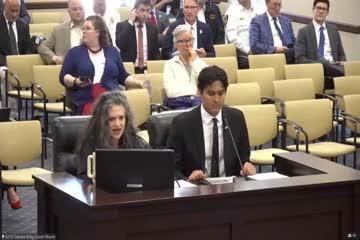Utah Senate proposes drowning prevention bill to fund statewide swimming education programs
January 29, 2025 | 2025 Utah Legislature, Utah Legislature, Utah Legislative Branch, Utah
This article was created by AI summarizing key points discussed. AI makes mistakes, so for full details and context, please refer to the video of the full meeting. Please report any errors so we can fix them. Report an error »

The Utah Senate Revenue and Taxation Committee convened on January 29, 2025, to discuss critical legislation aimed at enhancing water safety and emergency services funding. Central to the meeting was Senate Bill 108, which proposes a drowning prevention initiative designed to provide swimming education to at-risk communities, particularly children.
Senator Plumb, the bill's sponsor, emphasized the urgent need for drowning prevention measures, citing personal experiences and alarming statistics about drowning incidents in Utah. He noted that children in certain regions, particularly in the Southwest Utah Health District, are at double the risk of drowning compared to their peers in other areas. The proposed legislation seeks to establish a grant program administered by the Department of Health and Human Services, aimed at funding swimming lessons through local community organizations, such as recreation centers and non-profits.
The bill proposes an initial funding allocation of $250,000, which could be adjusted based on budgetary constraints. Senator Plumb highlighted the potential for significant long-term savings in healthcare costs associated with drowning incidents, arguing that teaching children to swim can drastically reduce the risk of drowning throughout their lives.
Committee members expressed support for the bill's objectives but raised concerns about the method of implementation and funding. Some senators suggested exploring existing grant opportunities from organizations like USA Swimming, while others questioned the necessity of a state-administered program when local governments could potentially manage such initiatives more effectively.
In a separate discussion, the committee also reviewed Senate Bill 67, which seeks to allow certain counties to implement a local option sales tax to fund emergency medical services (EMS). This bill aims to address the financial burden on property owners in areas heavily impacted by tourism, where a significant portion of emergency calls come from non-residents. Local officials argued that this measure would ensure that visitors contribute to the costs of the services they utilize.
As the committee deliberated, there was a clear consensus on the importance of both water safety education and adequate funding for emergency services. However, the discussions highlighted the complexities of funding mechanisms and the balance between state and local responsibilities. The committee ultimately decided to move on to the next agenda item, leaving the fate of these bills to be determined in future sessions.
The outcomes of these discussions could have lasting implications for community safety and health in Utah, particularly for vulnerable populations at risk of drowning and those relying on emergency services in tourist-heavy regions.
Senator Plumb, the bill's sponsor, emphasized the urgent need for drowning prevention measures, citing personal experiences and alarming statistics about drowning incidents in Utah. He noted that children in certain regions, particularly in the Southwest Utah Health District, are at double the risk of drowning compared to their peers in other areas. The proposed legislation seeks to establish a grant program administered by the Department of Health and Human Services, aimed at funding swimming lessons through local community organizations, such as recreation centers and non-profits.
The bill proposes an initial funding allocation of $250,000, which could be adjusted based on budgetary constraints. Senator Plumb highlighted the potential for significant long-term savings in healthcare costs associated with drowning incidents, arguing that teaching children to swim can drastically reduce the risk of drowning throughout their lives.
Committee members expressed support for the bill's objectives but raised concerns about the method of implementation and funding. Some senators suggested exploring existing grant opportunities from organizations like USA Swimming, while others questioned the necessity of a state-administered program when local governments could potentially manage such initiatives more effectively.
In a separate discussion, the committee also reviewed Senate Bill 67, which seeks to allow certain counties to implement a local option sales tax to fund emergency medical services (EMS). This bill aims to address the financial burden on property owners in areas heavily impacted by tourism, where a significant portion of emergency calls come from non-residents. Local officials argued that this measure would ensure that visitors contribute to the costs of the services they utilize.
As the committee deliberated, there was a clear consensus on the importance of both water safety education and adequate funding for emergency services. However, the discussions highlighted the complexities of funding mechanisms and the balance between state and local responsibilities. The committee ultimately decided to move on to the next agenda item, leaving the fate of these bills to be determined in future sessions.
The outcomes of these discussions could have lasting implications for community safety and health in Utah, particularly for vulnerable populations at risk of drowning and those relying on emergency services in tourist-heavy regions.
View full meeting
This article is based on a recent meeting—watch the full video and explore the complete transcript for deeper insights into the discussion.
View full meeting

